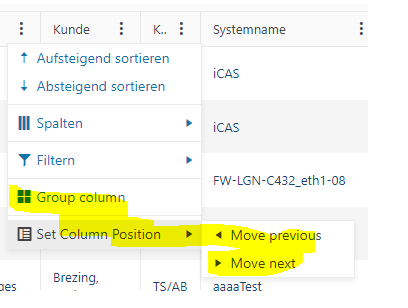Currently the ForeignKey column expects data to be loaded in it initially. This could be either local data or remote data.
For scenarios that involve using large data, it would be helpful if we can have more flexibility with the way data is loaded in the column's editor (e.g., DropDownList). For example, we want to use cascading ForeignKey editors. Once a selection is made in the first dropdown, the second cascades and is loaded with the respective data. This is not viable at the moment, because the data must be supplied to the ForeignKey column initially. If an empty collection is passed initially:
columns.ForeignKey(c => c.Field1, new List<SelectListItem>(), "Value", "Text").Width(100);and the dropdown is then loaded with data after the Grid's Edit popup opens, the ForeignKey column will display the DataFieldValue as text, because no initial data has been provided.
An option to load data on demand would be a welcome performance enhancement.
I would like to be able to create .bindBoolColumn. I do not want extend the column itself. I already have extensions for that.
Something like this:
GridBoundColumnBuilder<TModel> BoundBoolean<TValue>(Expression<Func<TModel, TValue>> expression)public GridBoundColumnBuilder<TModel> BoundBool<TValue>(Expression<Func<TModel, TValue>> expression)
{
column = *place create column code here*;
column.Width(90);
column.clientTemplate("customtemplate");
}
When using template and no DataSource is set Grid NoRecords message is not rendered.
Reproduction of the problem
Define a 'No Records' with template similar to the following article example: https://docs.telerik.com/aspnet-mvc/html-helpers/data-management/grid/templates/no-records
@(Html.Kendo().Grid<Grid_Template.Controllers.GridModel>()
.Name("Grid1")
.NoRecords(n => n.Template("string HTML template, not centered"))
)Current behavior
The default message for missing record is displayed: No records available.
"autoBind":false is applied to serialization
Expected/desired behavior
The message from the template is displayed: "string HTML template, not centered"
Workaround:
Add .DataSource(d => d.Ajax()) to the Grid configuration
@(Html.Kendo().Grid<Grid_Template.Controllers.GridModel>()
.Name("Grid1")
.NoRecords(n => n.Template("string HTML template, not centered"))
.DataSource(d => d.Ajax())
)
https://github.com/telerik/kendo-ui-core/issues/6598
Hi Team,
I'd like to request adding aggregation to the Kendo UI Grid Custom Ajax Binding Live Demo.
Thank you!
Hi Team,
I would like to request better integration when grouping using a viewModel. When grouping by defining the field in the group event using a model from EF, the Grid should continue to use the viewModel instead of the model's field. This would provide the Grid's group templates to be retained.
Please take a look at the following gif which shows the current behavior using the viewModel's RoomLocation field vs. the model's HomeRoom.RoomLocation.
Thank you!
Hi Team,
I'd like to request a similar example based on the virtualization of local data demo for UI for ASP.NET MVC.
Thank you!
Add a class to cells in a sorted column (similarly to the .k-sorted class in a sorted column's <th> element) to distinguish them from cells in unsorted columns.
Please could you update this example in your GitHub regarding how to export the Kendo UI Grid data on the server as ITextSharp is deprecated?
Thank you!
Hello telerik support,
recently we updated to 2023.2.718
somehow the grid column menu is not completely in german language
How can I apply german language to the complete column menu?
Best regards
Andy
Bug report
A hidden template column that is not included in the ColumnMenu appears after showing another column
Reproduction of the problem
- Use the following declaration for the columns:
.Columns(columns =>
{
//Hidden template column
columns.Template(x =>
{
int rptIndex = Model.IndexOf(x);
string namePrefix = "Grid[" + rptIndex + "].";
Html.Hidden(namePrefix + "Id", x.Id, new { @readonly = "readonly" });
Html.Hidden(namePrefix + "Name", x.Name, new { @readonly = "readonly" });
}).Hidden().IncludeInMenu(false);
columns.Bound(x => x.Id).Width(120).Hidden(true);
columns.Bound(x => x.Name).Width(200);
columns.Bound(x => x.ReportingDateOriginal).Width(500).HtmlAttributes(new { id = "reporting-date-original" })
.Filterable(f => f.UI(GridFilterUIRole.DateTimePicker).Cell(c => c.Template("dateFilter")));
columns.Bound(x => x.Test1).Width(200).Hidden(true);
columns.Bound(x => x.TimezoneOffset).Width(200).HtmlAttributes(new { id = "reporting-date-offset" });
columns.Bound(x => x.Test2).Width(200).Hidden(true);
columns.Bound(x => x.ReportingDateAdjusted).Width(500).HtmlAttributes(new { id = "reporting-date-adjusted" })
.Filterable(f => f.UI(GridFilterUIRole.DateTimePicker).Cell(c => c.Template("dateFilter")));
columns.Bound(x => x.Test3).Width(200);
columns.Bound(x => x.Test4).Width(200).Hidden(true);
columns.Bound(x => x.Test5).Width(200);
})
- Show the Id column
Current behavior
The first time instead of the Id, the template column appears.
Expected/desired behavior
The Id column should appear and the template column should remain hidden.
Environment
- Kendo UI version: 2024.1.130
- Browser: [all]

